Related Research Articles

Sayyed Abol-Ghasem Mostafavi-Kashani was an Iranian politician and Shia Marja.
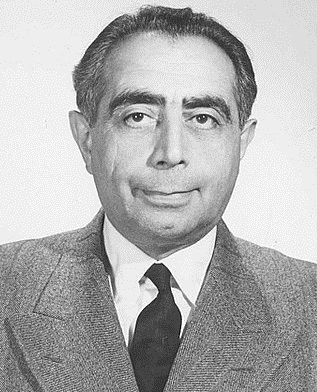
Ali Amini was an Iranian politician who was the Prime Minister of Iran from 1961 to 1962. He held several cabinet portfolios during the 1950s, and served as a member of parliament between 1947 and 1949.

Abdolhossein Hazhir was an Iranian politician who served as the Prime Minister of Iran under Mohammad Reza Pahlavi in 1948, having been a minister 10 times. One of his posts was the minister of finance.
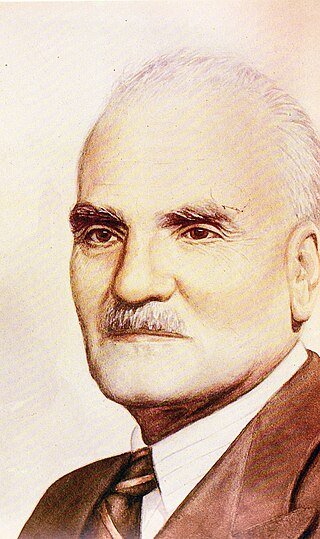
Sayyed Hasan Taqizādeh was an influential Iranian politician and diplomat, of Azeri origin, during the Qajar dynasty under the reign of Mohammad Ali Shah, as well as the Pahlavi dynasty under the reign of Reza Shah and Mohammad Reza Shah. Taqizadeh was also a prominent scholar; his studies on Iranian calendars remain reference work up until now.
Ettela'at is a Persian language daily newspaper of record published in Iran. It is among the oldest publications in the country, and the oldest running Persian daily newspaper in the world. The paper has a conservative stance and focuses on political, cultural, social and economic news. Until the revolution of 1979, the newspaper was associated with its chief founder Abbas Massoudi (1895-1974).
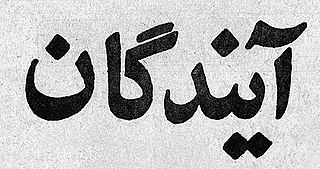
Ayandegan was one of the most influential and popular daily newspapers in Iran during Mohammad Reza Pahlavi's rule. It was the first morning daily paper of Iran. It had an independent and critical stance. The paper was also a liberal and nationalist publication in the Pahlavi period.
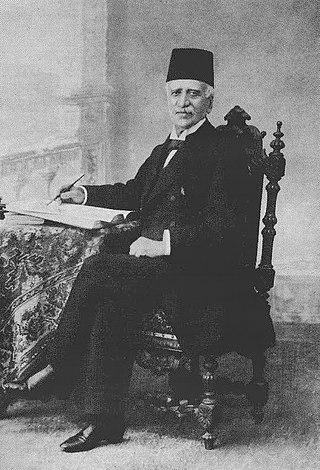
Mirza Melkum Khan, also spelled as Melkum Khan, was an Iranian modernist writer, diplomat, and publicist. He is known for his social reform efforts, as well as for being the first Christian to adopt the title of 'Mirza' in Persian. He is considered one of the fathers of the Iranian Constitutional Revolution.

Mirzā Jahāngir Khān, also known as Mirzā Jahāngir Khān Shirāzi and Jahāngir-Khān-e Sūr-e-Esrāfil, was an Iranian writer and intellectual, and a revolutionary during the Iranian Constitutional Revolution (1905–1911). He is best known for his editorship of the progressive weekly newspaper Sur-e Esrāfil, of which he was also the founder. He was executed, at the age of 38, or 32, for his revolutionary zeal, following the successful coup d'état of Mohammad-Ali Shah Qajar in June 1908. His execution took place in Bāgh-e Shāh in Tehran, and was attended by Mohammad-Ali Shah himself. He shared this fate simultaneously with his fellow revolutionary Mirzā Nasro'llah Beheshti, better known as Malek al-Motakallemin. It has been reported that immediately before his execution he had said "Long live the constitutional government" and pointed to the ground and uttered the words "O Land, we are [being] killed for the sake of your preservation [/protection]".
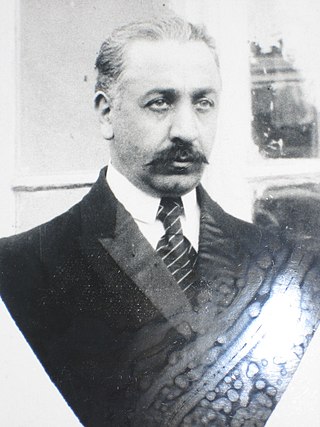
Mohammad Ali Tarbiat was an Iranian revolutionary, politician and reformist. He founded the Tarbiat library which was the first library in Iran. Tarbiat was a writer active in the Iranian Constitutional Revolution and a member of the National Consultative Assembly from the electorate of Tabriz (1931-1940).
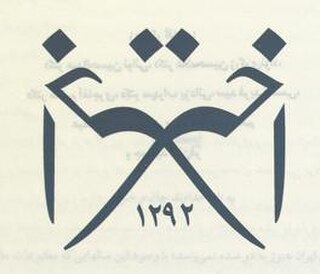
The Persian periodical Akhtar was published in Constantinople, Ottoman Empire, in the period 1876–1896.
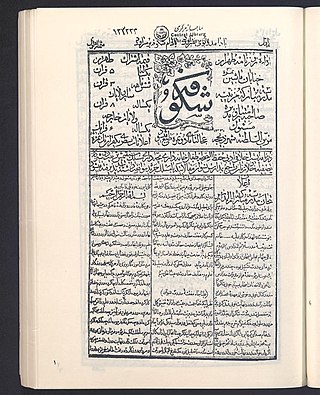
After the publication of the first Persian women’s magazine Danesh in Tehran in 1910–1911, Shokufeh, the next Persian magazine only for women, was established in 1913. The magazine was headquartered in Tehran and published on a biweekly basis. The editor was Maryam Amid Mozayen ol-Saltaneh, the daughter of Aqa Mirza Sayyed Razi Ra’is al-Atebba, a high-ranking medical advisor at the Qajar court. Almost at the same time, Mozayen ol-Saltaneh founded the Iranian Women’s Society Anjoman Khavatin Irani, which objectives she published in the Shokufeh magazine. She supported particularly the promotion of Iranian products and industry as well as education, science and art among women.
Hekmat was the first Persian-language newspaper published in Egypt, and the first Persian journal published in an Arab country. Founded and managed by the Iranian expatriate Mohammad-Mahdi Tabrizi, a physician by profession, it was published from 20 September 1892 until 30 May 1911. Hekmat carried primarily news, but also featured a variety of articles on political and social issues. Despite being published in an Arab country, it avoided using Arabic terms and Arabic forms of non-Arab words in its content.

The Persian-language magazine Habl al-Matin, one of the most important political journals during the Iran Constitutional Revolution, was published daily in Teheran from 1907 to 1908.
Ali Gheissari is an Iranian historian and sociologist. He teaches history at the University of San Diego and has research interest in the intellectual history of modern Iran and in modern philosophy and social theory. He has been visiting professor of religious studies at Brown University, Iranian Studies at St. Antony's College, Oxford, and History of Modern Iran at the University of California, Irvine. He is known for his works on the intellectual history and politics of modern Iran. He is on the Editorial Board of Iran Studies book series published by Brill, and has served as the Editor-in-Chief of the journal Iranian Studies.

The Iranian Enlightenment, sometimes called the first generation of intellectual movements in Iran, brought new ideas into traditional Iranian society from the mid-nineteenth to the early twentieth century. During the rule of the Qajar dynasty, and especially after the defeat of Iran in its war with the Russian Empire, cultural exchanges led to the formation of new ideas among the educated class of Iran. This military defeat also encouraged the Qajar commanders to overcome Iran's backwardness. The establishment of Dar ul-Fonun, the first modern university in Iran and the arrival of foreign professors, caused the thoughts of European thinkers to enter Iran, followed by the first signs of enlightenment and intellectual movements in Iran.
Nasim-e-Shomal was a weekly newspaper that existed between September 1907 and 1933 with intervals. It was one of the publications started following the Iranian constitutional revolution in addition to others, including Sur-e Esrafil and Majalleh-ye Estebdad.
Al Liwa was an Arabic language newspaper which was published in Cairo, Egypt, in the period 1900–1912. It was the first mass circulation newspaper in the country. The paper was founded by Mustafa Kamil Pasha. From its start in 1900 to the death of its founder in 1908 Al Liwa adopted a nationalist political stance. Between 1907 and 1910 it was the official organ of the Watani Party which was also established by Mustafa Kamil Pasha. The paper adopted a pan-Islamist political stance between 1908 and 1910. Al Liwa was not affiliated with the Watani Party from 1910 to August 1912 when it was closed down.
Mohammad Masud (1905–1948) was an Iranian journalist and writer. He published some books and launched a weekly newspaper, Mard-i Imruz. He was an ardent critic of the Pahlavi rule and Ahmad Qavam. Masud was assassinated in February 1948.

Qanun was a monthly newspaper which was published in London during the period 1890–1898. The founder and editor of the paper was Mirza Malkam Khan who served as the Qajar Iran's envoy to Britain and Italy. It is known to be the first oppositional publication of Iran and was one of the publications which improved the political awareness of Iranians.
Parvaresh was one of the Persian publications which were published in Cairo, Egypt. The paper was in circulation between 1900 and 1902. It was among the Persian publications published abroad which contributed to the political awakening of Iranians.
References
- 1 2 3 4 Nassereddin Parvin (2009). "Persian Journalism in Egypt". Encyclopædia Iranica .
- ↑ Amin Banani (1959). Impact of the West on Iran, 1921-1941: A study in modernization of social institutions (PhD thesis). Stanford University. p. 16. ISBN 9781084919372. ProQuest 301883678.
- 1 2 3 Kamran M. Dadkhah (July 1992). "Lebas-o Taqva: An Early Twentieth-Century Treatise on the Economy". Middle Eastern Studies. 28 (3): 550. doi:10.1080/00263209208700914.
- ↑ Ali Asghar Kia (1996). A review of journalism in Iran: the functions of the press and traditional communication channels in the Constitutional Revolution of Iran (PhD thesis). University of Wollongong. p. 166.
- ↑ Parvin Paidar (1997). Women and the Political Process in Twentieth-Century Iran. Cambridge: Cambridge University Press. p. 47. ISBN 978-0-521-59572-8.
- 1 2 3 Nikki R. Keddie (January 1969). "Iranian Politics 1900-1905: Background to Revolution". Middle Eastern Studies . 5 (1): 13,15. doi:10.1080/00263206908700116.
- ↑ Amir H. Ferdows (1967). The origins and development of the Persian constitutional movement (PhD thesis). Indiana University. p. 76. ISBN 9781085446808. ProQuest 302266220.